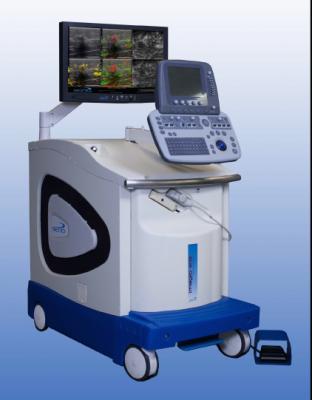
November 11, 2014 — Seno Medical Instruments Inc. announced that the use of the Seno Imagio breast imaging system and the associated predictive model appear to have the potential to significantly improve physicians' ability to accurately rule out breast cancer compared to traditional ultrasound alone.
"Diagnostic specificity, or the ability to accurately identify benign masses, remains disappointingly low for imaging methodologies optimized to identify all cancerous lesions with near 100-percent sensitivity," said A. Thomas Stavros, M.D., medical director, Seno Medical Instruments. "We believe that by training Imagio readers with this real-time predictive model, they may be able to accurately reclassify benign breast lesions to a lower BI-RADS score so the patient can confidently avoid a biopsy on benign masses. If confirmed by Seno's prospective, multicenter PIONEER Pivotal Study of Imagio, the predictive model may improve the image reader's ability to accurately characterize solid breast masses as cancerous or benign and to spare women with benign lesions from the biopsy process beyond the standard-of-care today."
The predictive model is based on key opto-acoustic features of breast masses obtained by Imagio during a 79-subject pilot study. Seno completed active enrollment of 2,100 subjects in the U.S.-based PIONEER study in September. The results of the study will serve as the basis for the company's Premarket Approval Application (PMA) with the U.S. Food and Drug Administration (FDA).
Stavros presented results of the parallel reader study, which was designed to prospectively test the predictive model, at the 18th SIS World Congress on Breast Healthcare. The meeting, hosted by the American Society of Breast Disease and by the Senologic International Society, took place in Orlando, Fla., Oct. 16-19, 2014.
To develop the real-time predictive model, an expert radiologist blinded to histologic outcomes evaluated traditional diagnostic breast ultrasound and the five different Imagio opto-acoustic features of 79 masses (41 benign, 38 cancer) classified BI-RADS 4 prior to biopsy. Linear regression was used to model and predict the probability of malignancy, while logistic regression was used to model and to predict whether a mass was benign or malignant.
Three independent radiologist readers analyzed the grayscale ultrasound images and assigned BI-RADS categories and percentage risk of malignancy (POM) to each mass. They then scored the five individual Imagio opto-acoustic features and assigned BI-RADS categories and POM to each mass based upon OA without the predictive model applied. Finally, the readers repeated the Imagio OA feature analysis and assignment of BI-RADS category and POM with the aid of the predictive model. All three independent radiologists identified all of the cancerous lesions with Imagio images, generating 100-percent sensitivity across all readers, while one cancer was missed on grayscale ultrasound. With Imagio OA without the predictive model the IRs achieved 11%, 24% and 25% better specificity than with conventional grayscale ultrasound. With the predictive model added, each independent radiologist was able to improve his/her ability to accurately classify a suspicious breast mass as benign by 28%, 36% and 38%, achieving better specificity than with conventional grayscale ultrasound, respectively. Incremental improvements in specificity attributable to the predictive model (over subjective assignment) were 17%, 12% and 13%.
Imagio was designed to identify two functional hallmarks of a potential malignancy: the presence of abnormal blood vessels (angiogenesis) and the relative reduction in oxygen content of hemoglobin. The technology is non-invasive and does not require contrast agents or radioisotopes, which are required for other modalities such as magnetic resonance imaging (MRI) or positron emission tomography (PET), nor does it use ionizing radiation (X-ray).
According to the American Cancer Society's estimates, 232,340 new cases of invasive breast cancer and an additional 64,640 cases of in situ breast cancer were diagnosed and approximately 39,620 women in the United States died from the disease during 2013. Only lung cancer accounts for more cancer deaths in women.
For more information: www.senomedical.com


 April 16, 2024
April 16, 2024 








